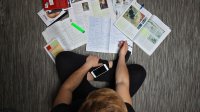Conquering the Multitasking Brain Drain
Contrary to popular belief, multitasking interferes with the quality of learning. These suggestions can help students recognize that scattered focus isn’t their friend during homework time.
Your content has been saved!
Go to My Saved Content.With the increasing surge of information and the compelling distractions of social media, videos, and games at their fingertips, students are understandably drawn to engage with these distractions during homework. Most kids believe they can have it all -- by multitasking. The fallacy is that when combining these activities with homework, they are getting less done, not more. That's because the brain doesn't multitask.
Teachers, parents, and students all suffer from brain-draining inefficiency when the focus on homework is disrupted by multitasking. Consequences such as inadequate sleep, languishing on the next day's learning, or late and low-quality assignments push parents and teachers into unpleasant roles as nags, helicopters, and rule-enforcers.
What is happening in the brain that makes multitasking so counterproductive? The brain is designed to limit conscious focus to one thing at a time. Our ancestors needed single focus to remain alive in their unpredictable world. The survival-in-the-wild brain that we humans inherited from them remains designed for unifocal tasking.
What feels like doing two things at once is actually the brain shifting its processing from one neural network to another. Each shift comes with a cost of consuming time, mental effort, and brain fuel. Microseconds are wasted as the brain turns off one active network and turns on the next. The result: less done and less remembered.
Neuro-Logical Self-Awareness Activity
Here is a self-inventory to guide students to an "aha!" awareness of how multitasking while doing homework actually results in adverse costs to their time and efficiency.
- Make a list of all the multitasking things (potential distractions) you like to do during homework. (Examples: internet or TV, responding to texts/calls/emails as they arrive, web surfing, frequent snack or game breaks.)
- Select a subject where homework assignments usually take about the same amount of time each night. If possible, choose a class whose homework is often useful for understanding the next lesson. (Examples: math homework or history assignments where chapters read are discussed the next day.)
- For the subject you choose, write your multitasking items on the following chart to collect data from your own observations.
This chart is designed to keep records of the time and outcome of homework done on alternating nights, with or without each multitasking distraction. Depending on how many multitasks are in a student's routine, it may take several nights to gather the data.
After gathering and evaluating their data, students will no doubt find evidence showing which multitasking distractions waste time and diminish success during homework. Invite discussions with questions such as:
- What did you discover?
- What multitask made your brain less efficient?
- Which do you want to resist?
Busting the Multitasking Urge
Students will discover that single-tasking, not multitasking, saves time. If reading texts and emails concurrently during homework are the big time sinks, they won't like your suggestion to turn off their phones or email. However, if parents ask for suggestions, here are some to offer:
- Turn off social media, messaging, and email.
- Silence their phones.
- Set a timer for regular breaks: five minutes for every 20 minutes of focused work. Their brains will be more focused knowing that they'll have a break for texting, checking email or Facebook, playing a video game, or doing physical activity. They won't be distracted by FOMO (fear of missing out) while working.
- Limit web browsing. Often, while scanning websites for homework assignments, they're tempted by links far more interesting than the assignment. To reduce the brain stress from concerns that they will lose those websites, suggest that they copy the hyperlinks onto a list to visit when time permits.
- Keeping a healthy snack and water nearby reduces the temptations to leave their work area.
- Write down what worked as a "go-to" resource when they need help staying on track.
Acknowledge Progress
To help students continue using self-assessment while becoming more independent, guide them to recognize progress and positive outcomes resulting from their insights and efforts.
It's certainly worthwhile pointing out that you'll no longer have to nag them. Happier students, teachers, and parents may be the best benefit of all.
